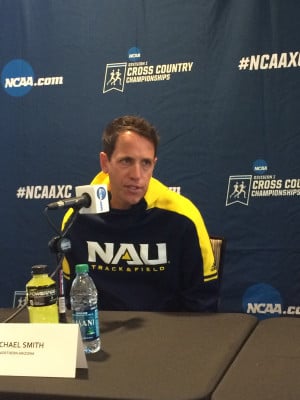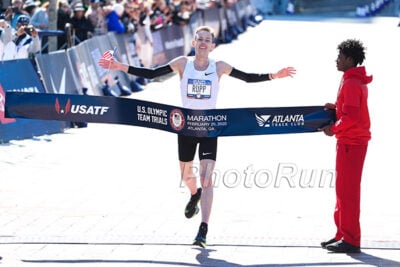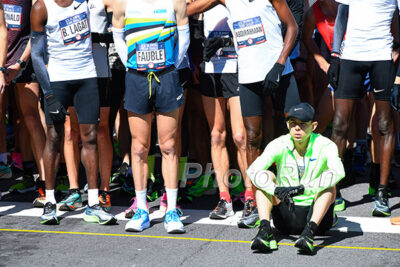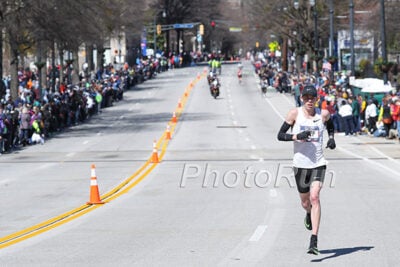Mike Smith Q&A, Part I: On Galen Rupp’s Commitment, Restructuring His Training & That 24×400 Workout
By LetsRun.com
March 18, 2020
It was one of the biggest questions in the running world once Alberto Salazar was banned from the sport for multiple anti-doping violations in September 2019: who would coach Galen Rupp? Though Salazar coached athletes such as Matthew Centrowitz and Mo Farah to Olympic gold medals, Rupp, whom he began coaching as a Portland high schooler almost two decades ago, had always been his star pupil. And Salazar was the only coach Rupp had ever had.
In January, we received an answer: Rupp turned to Mike Smith, the 39-year-old coach who guided Northern Arizona University to NCAA cross country titles in 2017 and 2018. Though Rupp remains based in Portland and Smith in Flagstaff, the two have met in person for some sessions since Smith began coaching Rupp in December. Rupp’s first major race under Smith was a smashing success, as he ran 2:09:20 to win the US Olympic Marathon Trials in Atlanta on February 29, 42 seconds ahead of runner-up Jake Riley.
One week after the Trials, Smith agreed to speak to LetsRun’s Jonathan Gault for a phone interview, with no subject off-limits. LetsRun is presenting the interview in two parts. Part I, in which Smith discusses the Trials, Rupp’s preparations, and the changes he’s made to Rupp’s training, is below. Part II, in which Smith discusses why he chose to work with Rupp in the wake of USADA’s investigation into the Nike Oregon Project (and subsequent ban of Salazar) will be published tomorrow.
JG: What surprised you or struck you the most about the Olympic Marathon Trials?
MS: First, as just a fan of our sport, just such a special moment for those people. We had this event here in [Flagstaff] where the athletes that live here in town that qualified for the Trials all came out to our high school auditorium and did a little Q&A. There’s 20-something people up there.
When you’re an athlete, you think it’s so much about the outcome — for them in this moment, whether you make the team or not. And I was sitting there thinking how it’s actually, we’re already so proud of them. They’ve already done it, before the race. Sitting in that high school auditorium, all these guys are wondering what place they’re gonna get, and they’ve already done it.
So I kind of had that feeling in the race of just these people, all this kind of comes into this moment. There’s these thrilling stories of these unknowns who make it, but man there’s a whole lot of heartbreak in there. The heartbreak I am interested in, because I think a lot of that begins with what people are telling themselves, initially, success is. So those are my first feelings on it.
In my college coaching job, we’ve had a men’s cross country team that’s competed for national titles the last few years. And we’ve done just a lot of work with them on expectation and the stories they tell themselves, our identity as a team, things like that. I have a lot of work in that, and I watch people who are favorites or people who have certain expectations, some of them master it on that day and then some of them had really challenging days, and I’m very interested in that. Because I think one of the big takeaways there was, man, throw performance lists out the window. It’s just more and more evidence of how you manage your mind.
And then of course, how those races played out, women’s race, so crazy to have all those superheroes together at 20 miles. Someone should take a photo of that moment right there, who those people are, what that is. And then in the men’s race, the volume of competitors at that pace over that terrain. You gotta take the numbers out, because the numbers alone don’t tell the story. You have to understand the numbers on that course and then the volume of athletes doing that. I mean, that was just like, woah.
The Trials were full of upsets, but Galen was the one guy who just didn’t seem affected by the course or the conditions. He did what everyone expected him to do. Why do you think he was able to do that?
Galen is a very physically talented athlete. His mind is way more advanced than his body. And remember, his body is pretty advanced.
He’s just so, so resilient. It ties into his physical preparations, but he is willing to grind like no other. He believes it’s gonna be the hardest thing he’s ever done. It’s an elite mindset that is just unbelievable. And part of resilience training is your ability to navigate what you can control, what’s a distraction, thinking traps or places you could talk yourself out of, what you need to do. When I say resilient in that way, he was just so dialed in for that moment.
His physical preparation was very good as well. He had come off [Achilles] surgery [in October 2018] and his mechanics were poor, he had weakness on his left side, and he was just in pain. And so I think, in the last two months, to have just stopped being in pain like that and to not have your day just evaluated by “am I in pain or not?” but actually, “am I training now?” I think he was really having fun with that. There was great joy injected into his process again that maybe he thought he wasn’t ever going to have.
So there was some life brought back into what he was doing. He was actually training for a marathon, to get ready for it. Between those elements, I think he was extremely ready for that moment.
Clearly he wasn’t totally healthy when he ran Chicago last fall (Rupp dropped out after 22 miles). What did it take for him to get over his injury issues? Did he need to change anything?
When I got to know him, the thing I couldn’t get over was what was he doing on that starting line that day? Because he was limping. They went out at 2:04 pace. One, what are you doing there? But two, he wasn’t letting himself off the hook. He was still going to try to do that, and obviously he couldn’t. That was probably rock bottom. I think what he needed was just time.
Sometimes what emerges from rock bottoms are, okay, something’s gotta change, I’ve gotta start over. So you finally exhale and give yourself the space to rebuild — physically, emotionally. But you can’t do that until you break. So first and foremost, he needed time. He has very, very talented people working on his strength and his mechanics, those resources are massive. But all that in the world, without time, doesn’t matter.
And in terms of his mechanics, did you guys alter anything? Did you try to rebuild him differently than how he was running before?
Sometimes with weakness, what you’re losing is your symmetry. So [we tried to create] an awareness of how asymmetry could lead to compensation. So while the weakness was in his left side, the right side is actually more or as problematic. Because these are things sometimes either just hard to see, even on video, but times hundreds of thousands of steps can make a big deal. Being conscious of that asymmetry at all times. So, for instance, modifications when any kind of fatigue or tightness on the right side emerges.
And then him just trying to learn to create force on that left side was very important. So when you’re cycling through [your stride], instead of the foot dropping, [having] the ability to push [off the ground]. That kind of power output, that wasn’t probably even where it needed to be February 1. The weeks even leading into [the Trials], that was coming along and it still probably has a little ways to go. From an energy expenditure standpoint, if you’re not pushing through, there’s going to be a cost there.
So making sure he’s able to monitor that himself and be aware of that kind of cueing. And making sure we’re structuring the demands in his training to factor in where he is with that. And also make sure we’re cutting things off where they need to cut off before bad habits emerge.
This is a guy who won two Olympic medals before he underwent this surgery. Are you confident he can return to his pre-injury level of performance?
I didn’t know him then. [With] the mindset he has? Oh, no doubt. His mind is like, no question.
[The] body changes as athletes age, even without surgery. The question to him should be how open he’s going to be to new sources of confidence. So instead of just, well eight years ago, I split this in this workout, and that’s how I knew I was ready to go, if the sources of his confidence can be derived from other places, not just the numbers, then I think he stands a good chance.
And if he’s open to some of the ways that he’s gonna have to alter recovery. Instead of, maybe, in 48 hours [he] could be ready to go again, maybe now it’s 72 hours, or things like that. Remaining fluid with some of the changes, I think, would be the essential piece of that.
But I think it is also different, what you need to do to prepare for championship track racing and championship marathoning. So I think that more aligns with where he is now. The big question now is where can his speed go? And, you know, I’m just not sure of that.
You praised his mind multiple times. You mentioned resilience as a big part of that. Is there any other part that you think is just central to his success? What is it about his mind that makes him successful?
Resilience can be tied to focus. It can be tied to his toughness. When I work with young athletes, we really focus on balance, because you have to be a happy human to run your best. You can have an athlete with an injury who says, hey can I aquajog for five hours a day? And the reason we say no, you can’t aquajog for five hours a day, is because we think that’s not good for you. That’s not good for your wellbeing. I know you want to work hard and things like that, but there’s a limit to everything that we do where we cross into a place that’s too emotionally taxing or it stresses you out. So we’re often trying to find this balance.
But if I can get a college kid to sleep eight hours a night and not think that that’s the biggest sacrifice ever and they’re okay with that, it frees them up to use those resources in all these other places. And so when you have someone who has carefully structured a life in this attempt to try be the best he can be and then put a lot of resources behind that…
Even from a standard of professionals, Galen works really, really hard on all the minutiae, down to the 1%. But a lot of people work hard. He does it in a way that I don’t think he thinks is a sacrifice or that it’s only worth it if I’m rewarded with this result.
He’s pursuing excellence. I think in our sport, you can find lots of people that will do the little X’s and O’s if they’re paid back in some way. Or the barrier to them doing the X’s and O’s is that it just costs them so much. And that’s where his gift in his mind is. He has embraced a process and a lifestyle that is just very, very elite, if that makes sense. People will do that, but man, it costs them. I think he’s got things structured in a way that it doesn’t. He’s able to do all that because he loves it and he loves the process of it.
I think of college kids who think like, man I’m doing everything I can do. And then they meet professionals and say this is what recovery looks like. Or this is what nutrition looks like. I even think in this realm, we have this really wide realm of what we call professional running, where even in there, there’s all these degrees. And yeah, you’re talking about the one-percenters. And that’s a different world.
What do you think is one thing he does that no one else would do, one of those minutiae, 1% things that even among pros would be pretty rare?
For starters, he lives in a home that’s set to 10,000 feet elevation. But in order for that to work, you’ve gotta be in the house. It’s just like altitude tents. Lots of people use altitude tents, but what’s the limitation to altitude tents? You’ve gotta be in the tent. And you’ve gotta be in the tent even more than you’re sleeping. So again, people are like man, I want to use this altitude tent but it’s hot and stuffy and I’m going stir-crazy in here.
So one, can you have the resources to fix that barrier so you’re not in a plastic bag, but you’re living in Nepal? Well, what’s the limitation of living in Nepal? Well we might go crazy out there because we’re away from our friends and our family. So what if we could have our friends and family right there — because those are the people that make us happy — and still have that elevation? I mean, who has the resources to do that?
But then next: find me someone that’s willing to be in their house 18 hours a day for a decade. I mean, how long can you do that? I’m just saying, you’re talking about someone that is trying to intelligently structure this in a way that is going to have him at his very best.
I go to meets all over the country every weekend and I watch everyone warm up, not just the people I coach. We’re still in a place where I’m not sure we’re concerned if we do drills correctly. I observe people who are really fixated on getting pictures of themselves. And then you’ve got somebody that’s gonna sleep at 11,000 feet. I think USATF said it’s like 0.5% is the difference in medaling or not. Where are you gonna get those percents?
And I get it: the first place people think is that you have to sacrifice your integrity to get the percents. And I would just say that there are lots of places you can exhaust with your full integrity before you ever have to go there. When you get an insight into high performance and all the brilliant minds in this world, some of the brilliant minds just even in our country…when you have great resources and great motivation and brilliant minds, there are a whole bunch of things [you can do to improve without sacrificing your integrity]. I think we’re gonna find out in 100 years that we were just really early on in this stuff.
What about his training? What changes have you made, if any? What kind of stuff is he doing that he might not have done under Alberto?
When he first called me and [I] kind of had that six weeks of asking him questions and thinking about this, one of the things is I’ve always been just really honest with him. [I told him], I know how hard it is for athletes to change things they’re used to, and no disrespect to your training, there’s just going to be things that are different.
I mean, you’re talking about a guy who’s 33 years old, he’d never done a fartlek. There’s going to be things that are different. And forget everything else we’ve gotta think about here or I have to think about here, but if we could even get to this place to proceed, have you really thought through that you’re gonna be doing things that you’ve never done before or you’re not comfortable with or that you have no confidence in, you have no previous experience with. And you’re going to be doing them at a time when there’s a bunch on the line and sometimes your emotional reserves will be low and you’ll be frustrated. Are you willing to do that stuff? And even when he said yes, I was like, yeah, we’ll see. It’s easy to say yes.
So I really applaud him on that. It’s like anybody, any human, we retreat to what’s comfortable and we know what’s secure and safe. And you’re training for this huge race and someone you don’t know is telling you to do these workouts you’ve never done before, it’s a lot to ask.
A big difference would just be everything he did was on 400-meter jog recovery. I use workouts like that sometimes too when I don’t want the velocity limited by the recovery and I want the athlete to just go when they’re ready to go. But 400 jog, that could be two minutes, it could be six minutes, I don’t know. And so a lot of my workout structures have organized recovery.
Particularly when we’re working on the aerobic system, we’re building volume and things, I use high volume, short rest. He’d never done that in his life. We missed on a couple of those workouts. And they were probably some of the most frustrating periods for him because he never had to be back on the line in 60 seconds [before].
He seriously had never done a fartlek before he started working with you?
No. And I use a lot of fartlek because we’re at altitude. I really like effort-based stuff, especially early on. And I use fartlek a lot to prepare for future workouts. I had to explain some of these pieces of it. But again, I appreciate that he trusted me. I respect that, because we’re not getting him ready for the Fourth of July Firecracker 5K. This is important stuff. Elite athletes get really crazy when their preparation isn’t exact. I think it says a lot about him.
I was going to ask about one workout specifically. Craig Masback mentioned on the broadcast he did 20 x 400 in 60 seconds after his half marathon in Arizona. That workout just sounds incredible to me. What was the rest on that? And how many marathoners could run that session, do you think?
We did four sets of six of those 400’s. I like high volume, I like work that’s high-volume economy work. And with his injury, the thing that we were going to have to do was get him efficient with those weaknesses, like I was talking about with pushing down and that force production.
Because aerobically, the engine was good. It was the infrastructure that was going to be the limitation. He had derived a lot of confidence from pushing. And if we get into those long intervals with limitations in inefficiency, it’s too great a risk, and we potentially threaten the overall work. And so we had to attack his economy with a lot of stuff that I would call 1500-meter type effort. The mistake would be to make them faster than that or do less of them, so we’ve gotta have the intensity right to get the volume.
That was one of many workouts that we did, starting with 150s and building up to 200s and 300s, and cycling in a lot of that work with treadmill hills and things like that, just getting him economical.
That was a day that was a sign that that left side, the strength was holding up. It hurt, but the energy cost was finally kind of clicking. The splits are the splits, but I was kind of surprised people thought that was a big deal. Maybe it’s the volume they think is a big deal. But I use volumes like that all the time.
You’ve gotta remember that there’s a dozen workouts that have to lead in to be able do something like that that look less impressive. But I think that was a day that was like, okay, this is kind of clicking.
(Regarding the rest, Smith said it was a few minutes between reps and a big break between sets).
I think it’s the volume — you said four sets of six 400’s. That’s six miles at close to 4:00 mile pace. For any distance runner, I’d imagine that would be pretty tough, even for a 5k/10k guy.
That kind of category of work, if we’re doing that, and we had about double the rest, Jack [Daniels] would say, that volume, actually, if you look at what his weekly volume is and things like that, is about right. I think what we were shooting for was like 61-62 and that’s saying that mile fitness is 4:04, 4:08, something like that. He squeezes out some tenths and now we’re in the 60-second area. The NAU kids would be laughing at that like, all he did was 24? But it was a good session.
He learned to derive confidence from speed because he came up to the marathon distance through 5k and 10k. I look it as, his economy, we’ve got to get it really efficient to run 4:40 pace. He looks at it as, I’m ready to go when I get fast again. So we probably left that day happy for different reasons.
Talk about this interview on our world famous messageboard / fan forum. MB: Mike Smith lifts the veil on Galen Rupp’s training and talks about what makes him great
This interview has been lightly condensed for clarity.




